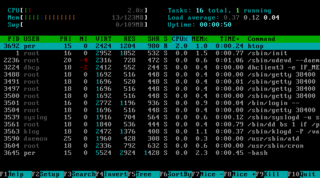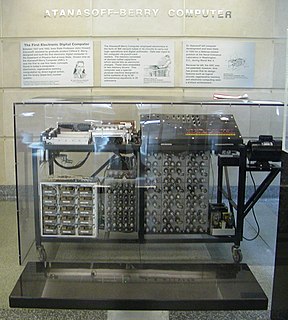A complex instruction set computer is a computer in which single instructions can execute several low-level operations or are capable of multi-step operations or addressing modes within single instructions. The term was retroactively coined in contrast to reduced instruction set computer (RISC) and has therefore become something of an umbrella term for everything that is not RISC, where the typical differentiating characteristic is that most RISC designs use uniform instruction length for almost all instructions, and employ strictly separate load and store instructions.

The Intel 80286 is a 16-bit microprocessor that was introduced on February 1, 1982. It was the first 8086-based CPU with separate, non-multiplexed address and data buses and also the first with memory management and wide protection abilities. The 80286 used approximately 134,000 transistors in its original nMOS (HMOS) incarnation and, just like the contemporary 80186, it could correctly execute most software written for the earlier Intel 8086 and 8088 processors.

In computing, a process is the instance of a computer program that is being executed by one or many threads. It contains the program code and its activity. Depending on the operating system (OS), a process may be made up of multiple threads of execution that execute instructions concurrently.

A superscalar processor is a CPU that implements a form of parallelism called instruction-level parallelism within a single processor. In contrast to a scalar processor that can execute at most one single instruction per clock cycle, a superscalar processor can execute more than one instruction during a clock cycle by simultaneously dispatching multiple instructions to different execution units on the processor. It therefore allows for more throughput than would otherwise be possible at a given clock rate. Each execution unit is not a separate processor, but an execution resource within a single CPU such as an arithmetic logic unit.

Parallel computing is a type of computation where many calculations or the execution of processes are carried out simultaneously. Large problems can often be divided into smaller ones, which can then be solved at the same time. There are several different forms of parallel computing: bit-level, instruction-level, data, and task parallelism. Parallelism has long been employed in high-performance computing, but has gained broader interest due to the physical constraints preventing frequency scaling. As power consumption by computers has become a concern in recent years, parallel computing has become the dominant paradigm in computer architecture, mainly in the form of multi-core processors.
In computer architecture, 64-bit integers, memory addresses, or other data units are those that are 64 bits wide. Also, 64-bit central processing unit (CPU) and arithmetic logic unit (ALU) architectures are those that are based on processor registers, address buses, or data buses of that size. 64-bit microcomputers are computers in which 64-bit microprocessors are the norm. From the software perspective, 64-bit computing means the use of machine code with 64-bit virtual memory addresses. However, not all 64-bit instruction sets support full 64-bit virtual memory addresses; x86-64 and ARMv8, for example, support only 48 bits of virtual address, with the remaining 16 bits of the virtual address required to be all 0's or all 1's, and several 64-bit instruction sets support fewer than 64 bits of physical memory address.

A digital signal processor (DSP) is a specialized microprocessor chip, with its architecture optimized for the operational needs of digital signal processing. DSPs are fabricated on MOS integrated circuit chips. They are widely used in audio signal processing, telecommunications, digital image processing, radar, sonar and speech recognition systems, and in common consumer electronic devices such as mobile phones, disk drives and high-definition television (HDTV) products.
Transmeta Corporation was an American fabless semiconductor company based in Santa Clara, California. It developed low power x86 compatible microprocessors based on a VLIW core and a software layer called Code Morphing Software.

The Crusoe is a family of x86-compatible microprocessors developed by Transmeta and introduced in 2000. Crusoe was notable for its method of achieving x86 compatibility. Instead of the instruction set architecture being implemented in hardware, or translated by specialized hardware, the Crusoe runs a software abstraction layer, or a virtual machine, known as the Code Morphing Software (CMS). The CMS translates machine code instructions received from programs into native instructions for the microprocessor. In this way, the Crusoe can emulate other instruction set architectures (ISAs).
In computing, binary translation is a form of binary recompilation where sequences of instructions are translated from a source instruction set to the target instruction set. In some cases such as instruction set simulation, the target instruction set may be the same as the source instruction set, providing testing and debugging features such as instruction trace, conditional breakpoints and hot spot detection.

Instruction-level parallelism (ILP) is a measure of how many of the instructions in a computer program can be executed simultaneously.
Simultaneous multithreading (SMT) is a technique for improving the overall efficiency of superscalar CPUs with hardware multithreading. SMT permits multiple independent threads of execution to better utilize the resources provided by modern processor architectures.
Loop unrolling, also known as loop unwinding, is a loop transformation technique that attempts to optimize a program's execution speed at the expense of its binary size, which is an approach known as space–time tradeoff. The transformation can be undertaken manually by the programmer or by an optimizing compiler. On modern processors, loop unrolling is often counterproductive, as the increased code size can cause more cache misses; cf. Duff's device.
In compiler theory, loop optimization is the process of increasing execution speed and reducing the overheads associated with loops. It plays an important role in improving cache performance and making effective use of parallel processing capabilities. Most execution time of a scientific program is spent on loops; as such, many compiler optimization techniques have been developed to make them faster.

BMDFM is software that enables running an application in parallel on shared memory symmetric multiprocessors (SMP) using the multiple processors to speed up the execution of single applications. BMDFM automatically identifies and exploits parallelism due to the static and mainly DYNAMIC SCHEDULING of the dataflow instruction sequences derived from the formerly sequential program.
Rabbit Semiconductor is an American company which designs and sells the Rabbit family of microcontrollers and microcontroller modules. For development, it provides Dynamic C, a non-standard dialect of C with proprietary structures for multitasking.
A computer architecture simulator is a program that simulates the execution of computer architecture.
Task parallelism is a form of parallelization of computer code across multiple processors in parallel computing environments. Task parallelism focuses on distributing tasks—concurrently performed by processes or threads—across different processors. In contrast to data parallelism which involves running the same task on different components of data, task parallelism is distinguished by running many different tasks at the same time on the same data. A common type of task parallelism is pipelining which consists of moving a single set of data through a series of separate tasks where each task can execute independently of the others.
The history of general-purpose CPUs is a continuation of the earlier history of computing hardware.
The Sieve C++ Parallel Programming System is a C++ compiler and parallel runtime designed and released by Codeplay that aims to simplify the parallelization of code so that it may run efficiently on multi-processor or multi-core systems. It is an alternative to other well-known parallelisation methods such as OpenMP, the RapidMind Development Platform and Threading Building Blocks (TBB).







